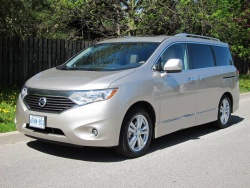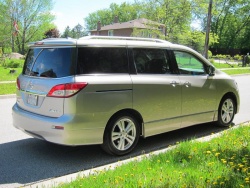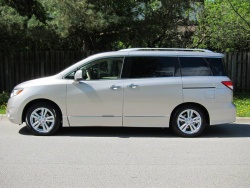 2011 Nissan Quest LE. Click image to enlarge |
|
Related links
Manufacturer’s web site |
Review and photos by Jil McIntosh
Photo Gallery:
2011 Nissan Quest
Sidebar:
Teaching an old dog new tricks
For the most part, the manufacturers that make minivans have stayed fairly true to their designs, with only gradual modifications. That’s not the case with Nissan. Its first Quest models were versions of Ford vans. When the “blue oval” left the minivan market, Nissan turned to its factory in Mississippi and built its own van, with a decidedly odd interior that the company redesigned a couple of years later to make it more mainstream.
The Quest left the Canadian market for 2010, but is back in its fourth generation. This time around, it’s made in Japan and is a version of a van called the Nissan Elgrand that’s sold overseas. Sitting near or at the top of the competitors’ price range, with oddball styling but with an interior that rivals some luxury sedans, it’s out to make its mark in a segment that has had its ups and downs but never entirely goes away.
It comes in four trim levels: the S at $29,998, the SV for $35,048, the SL at $38,798, and my tester, the top-line LE, which is $48,498 and was upped with a dual-pane sunroof on mine for another $2,000. That’s a lot of money. Comparing MSRPs, the starting price is topped only by Chrysler’s Town & Country, and by the base Toyota Sienna all-wheel drive. At the other end, among the highest trim levels, no other front-wheel-drive minivan costs more. If you load up a Grand Caravan to pretty much the same level of features, it’s $7,400 less than my tester.
  2011 Nissan Quest LE. Click image to enlarge |
It’s based on Nissan’s “D” Platform, which underpins the Murano and other models, and uses a 3.5-litre V6 mated to a continuously variable transmission (CVT), the only minivan on the market to use one. It’s exclusively front-wheel drive: Toyota makes the only minivan with an all-wheel option. The V6 makes 260 horsepower and 240 lb.-ft. of torque, which puts it about mid-pack with its competition: Toyota’s four-cylinder makes 187 horses, while Honda Odyssey’s V6 makes 248. Chrysler’s minivan siblings – Dodge Grand Caravan, Chrysler Town & Country and the Volkswagen-badged Routan – top the list at 283 horsepower.
I have no complaints about the engine, which feels strong and with smooth acceleration. The CVT is a pleasant surprise, too. These gearless transmissions can sometimes produce an unappealing driving experience, but this one is perfectly suited to the vehicle. But the suspension is mushy and soft and the steering is light. That may well appeal to a large number of drivers, who will interpret it as a luxury feel – and there’s nothing wrong with that if they do. Those who like a little more road feel will find the Quest to be squishy over bumps, and there’s a lot of lean in the corners.
Nissan’s not afraid to go out on a limb with its styling ventures – witness the Cube and Juke – and the Quest is no exception. Each to his or her own, of course, but I don’t really want to see this van in the swimsuit competition. A graceful curve along the side is the sole saving grace alongside its angular nose and big square butt. The high beltline and short windows help to make it look like the biggest on the block, but it’s actually shorter and narrower than most of the competition (you can expect some visibility issues thanks to that smaller expanse of glass, too). It’s the tallest, though, towering anywhere from 43 to 129 mm over its rivals. Even so, Nissan claims that a unique sliding door rail system gives it the lowest step-in height of all vans, which can be important for small children or elderly passengers who may have trouble getting up into a higher one.











